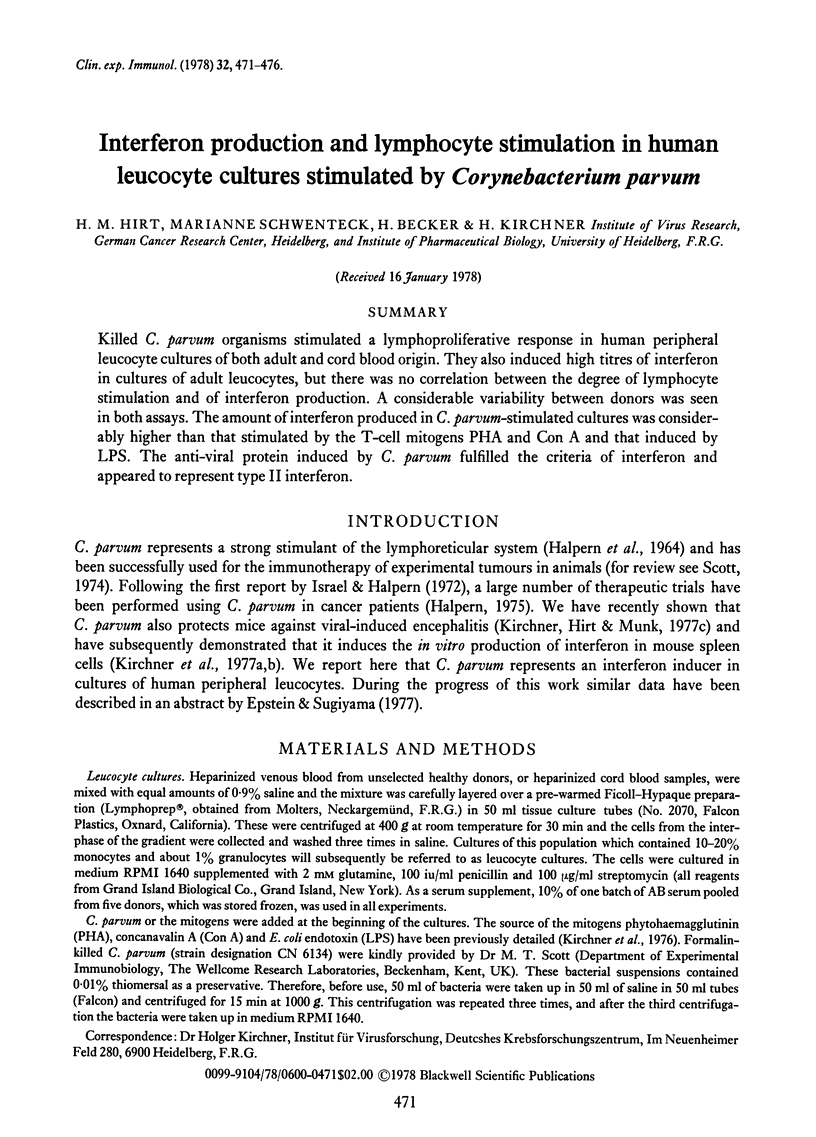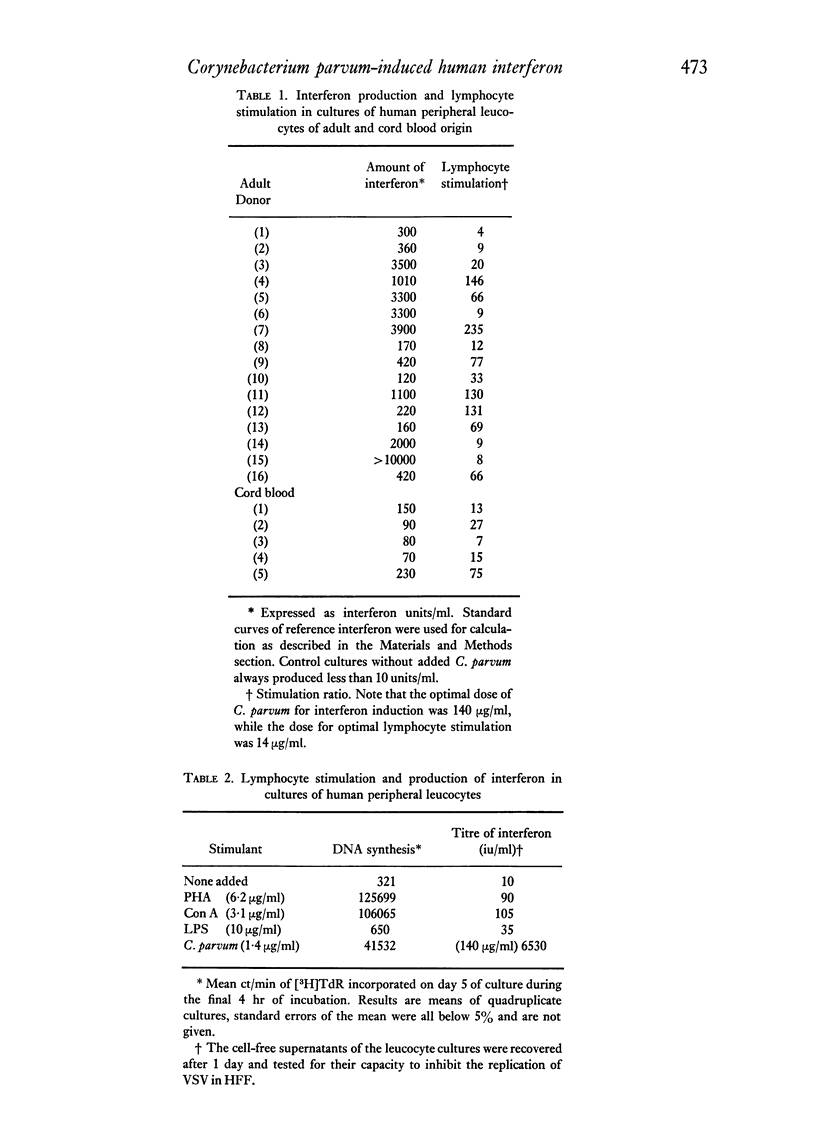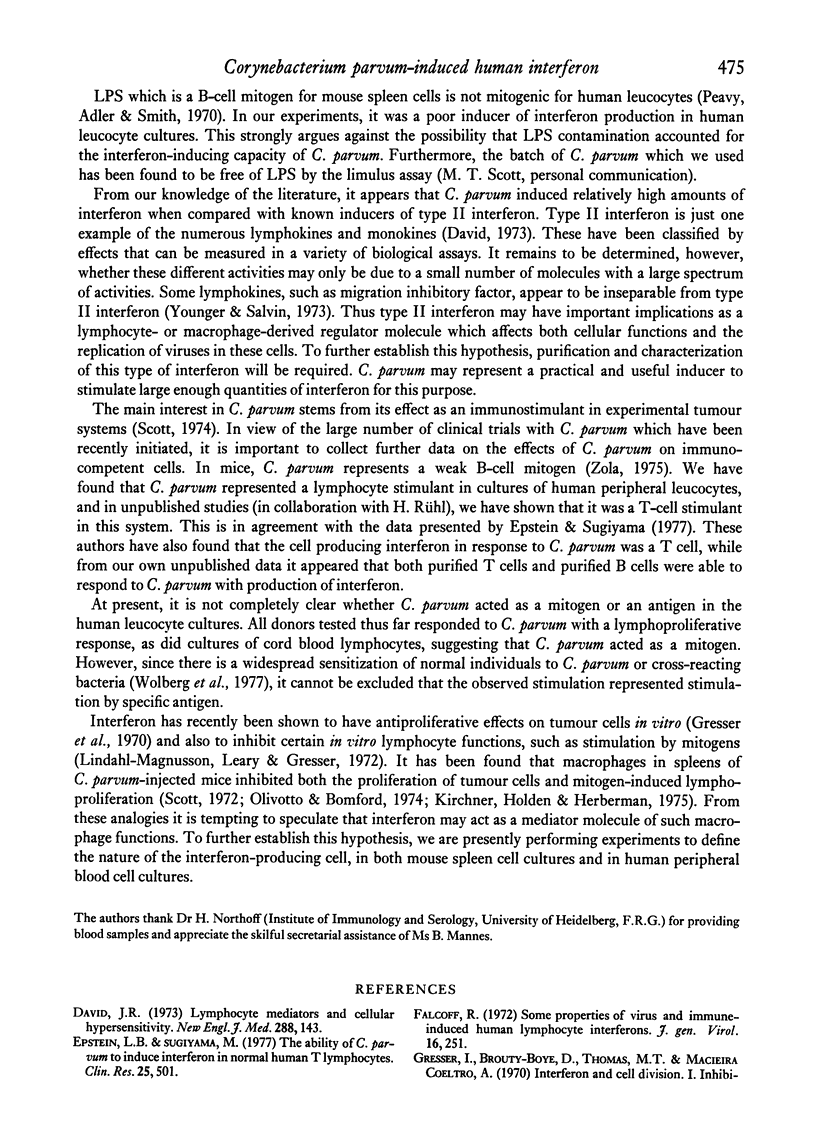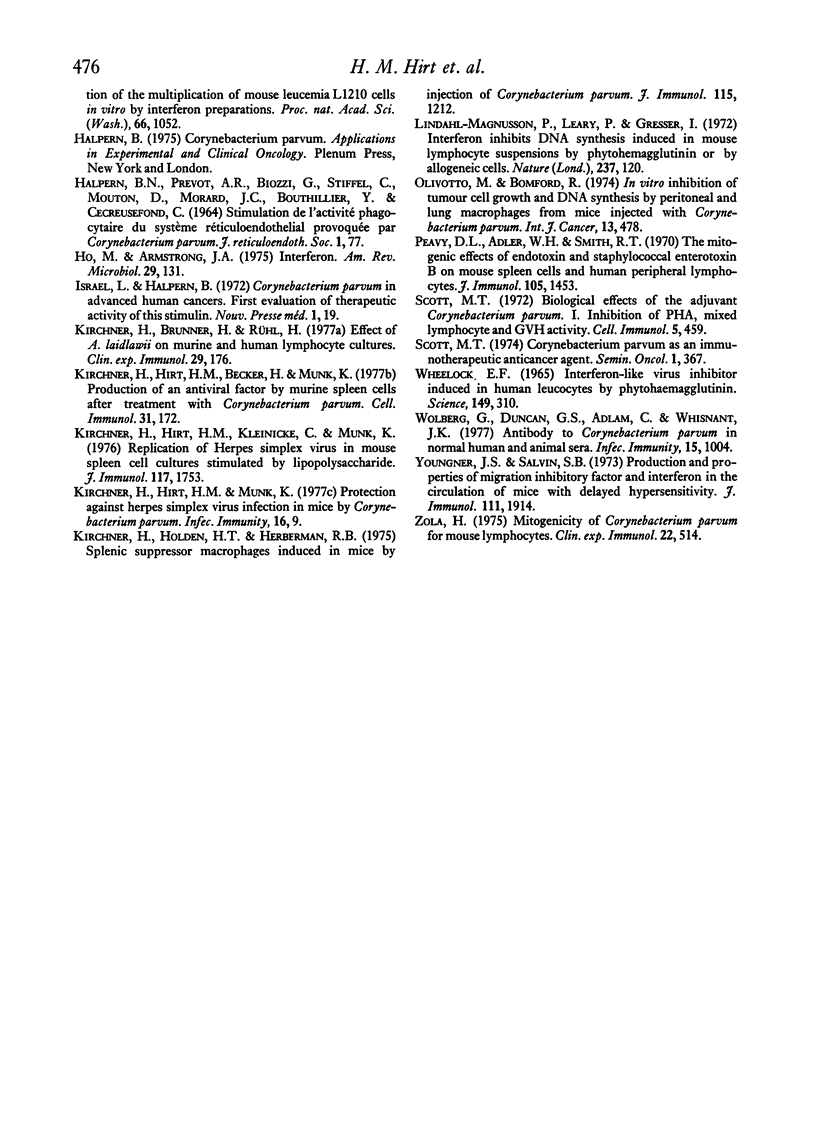Abstract
Killed C. parvum organisms stimulated a lymphoproliferative response in human peripheral leucocyte cultures of both adult and cord blood origin. They also induced high titres of interferon in cultures of adult leucocytes, but there was no correlation between the degree of lymphocyte stimulation and of interferon production. A considerable variability between donors was seen in both assays. The amount of interferon produced in C. parvum-stimulated cultures was considerably higher than that stimulated by the T-cell mitogens PHA and Con A and that induced by LPS. The anti-viral protein induced by C. parvum fulfilled the criteria of interferon and appeared to represent type II interferon.
Full text
PDF





Selected References
These references are in PubMed. This may not be the complete list of references from this article.
- David J. R. Lymphocyte mediators and cellular hypersensitivity. N Engl J Med. 1973 Jan 18;288(3):143–149. doi: 10.1056/NEJM197301182880311. [DOI] [PubMed] [Google Scholar]
- Falcoff R. Some properties of virus and immune-induced human lymphocyte interferons. J Gen Virol. 1972 Aug;16(2):251–253. doi: 10.1099/0022-1317-16-2-251. [DOI] [PubMed] [Google Scholar]
- Gresser I., Brouty-Boyé D., Thomas M. T., Macieira-Coelho A. Interferon and cell division. I. Inhibition of the multiplication of mouse leukemia L 1210 cells in vitro by interferon preparations. Proc Natl Acad Sci U S A. 1970 Aug;66(4):1052–1058. doi: 10.1073/pnas.66.4.1052. [DOI] [PMC free article] [PubMed] [Google Scholar]
- HALPERN B. N., PREVOT A. R., BIOZZI G., STIFFEL C., MOUTON D., MORARD J. C., BOUTHILLIER Y., DECREUSEFOND C. STIMULATION DE L'ACTIVIT'E PHAGOCYTAIRE DU SYST'EME R'ETICULOENDOTH'ELIAL PROVOQU'EE PAR CORYNEBACTERIUM PARVUM. J Reticuloendothel Soc. 1964 Jan;1:77–96. [PubMed] [Google Scholar]
- Kirchner H., Brunner H., Rühl H. Effect of A. laidlawii on murine and human lymphocyte cultures. Clin Exp Immunol. 1977 Jul;29(1):176–180. [PMC free article] [PubMed] [Google Scholar]
- Kirchner H., Hirt H. M., Becker H., Munk K. Production of an antiviral factor by murine spleen cells after treatment with Corynebacterium parvum. Cell Immunol. 1977 Jun 1;31(1):172–176. doi: 10.1016/0008-8749(77)90016-8. [DOI] [PubMed] [Google Scholar]
- Kirchner H., Hirt H. M., Kleinicke C., Munk K. Replication of herpes simplex virus in mouse spleen cell cultures stimulated by lipopolysaccharide. J Immunol. 1976 Nov;117(5 PT2):1753–1756. [PubMed] [Google Scholar]
- Kirchner H., Hirt H. M., Munk K. Protection against herpes simplex virus infection in mice by Corynebacterium parvum. Infect Immun. 1977 Apr;16(1):9–11. doi: 10.1128/iai.16.1.9-11.1977. [DOI] [PMC free article] [PubMed] [Google Scholar]
- Kirchner H., Holden H. T., Herberman Splenic suppressor macrophages induced in mice by injection of Corynebacterium parvum. J Immunol. 1975 Nov;115(5):1212–1216. [PubMed] [Google Scholar]
- Lindahl-Magnusson P., Leary P., Gresser I. Interferon inhibits DNA synthesis induced in mouse lymphocyte suspensions by phytohaemagglutinin or by allogeneic cells. Nat New Biol. 1972 May 24;237(73):120–121. doi: 10.1038/newbio237120a0. [DOI] [PubMed] [Google Scholar]
- Olivotto M., Bomford R. In vitro inhibition of tumour cell growth and DNA synthesis by peritoneal and lung macrophages from mice injected with Corynebacterium parvum. Int J Cancer. 1974 Apr 15;13(4):478–488. doi: 10.1002/ijc.2910130406. [DOI] [PubMed] [Google Scholar]
- Peavy D. L., Adler W. H., Smith R. T. The mitogenic effects of endotoxin and staphylococcal enterotoxin B on mouse spleen cells and human peripheral lymphocytes. J Immunol. 1970 Dec;105(6):1453–1458. [PubMed] [Google Scholar]
- Scott M. T. Biological effects of the adjuvant Corynebacterium parvum. I. Inhibition of PHA, mixed lymphocyte and GVH reactivity. Cell Immunol. 1972 Nov;5(3):459–468. doi: 10.1016/0008-8749(72)90072-x. [DOI] [PubMed] [Google Scholar]
- Scott M. T. Corynebacterium parvum as an immunotherapeutic anticancer agent. Semin Oncol. 1974 Dec;1(4):367–378. [PubMed] [Google Scholar]
- Wolberg G., Duncan G. S., Adlam C., Whisnant J. K. Antibody to Corynebacterium parvum in normal human and animal sera. Infect Immun. 1977 Mar;15(3):1004–1007. doi: 10.1128/iai.15.3.1004-1007.1977. [DOI] [PMC free article] [PubMed] [Google Scholar]
- Youngner J. S., Salvin S. B. Production and properties of migration inhibitory factor and interferon in the circulation of mice with delayed hypersensitivity. J Immunol. 1973 Dec;111(6):1914–1922. [PubMed] [Google Scholar]
- Zola H. Mitogenicity of Corynebacterium parvum for mouse lymphocytes. Clin Exp Immunol. 1975 Dec;22(3):514–521. [PMC free article] [PubMed] [Google Scholar]


